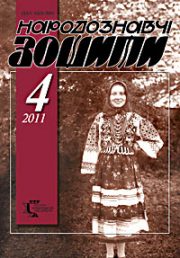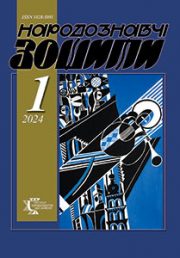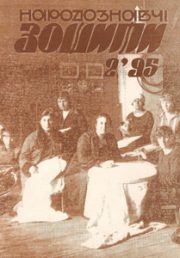The Ethnology Notebooks. 2020. # 6 (156), 1427—1436
УДК 37.091.011.3: 94—051
DOI https://doi.org/10.15407/nz2020.06.1427
Vasyl SOKIL
- ORCID ID: http://orcid.org/0000-0003-3164-1217
- Doctor of Philology, Professor, Head of Department,
- The Ethnology Institute National Academy of Sciences of Ukraine
- Department of Folklore,
- 15, Svobody ave., 79000, Lviv, Ukraine.
- е-mail: vasylsokil@gmail.com
This publication focuses on the history of religious life in the village ofVolosianka in the modern period covering the time lapse from the 1980s up to date. Itintroduces for the first time the information about the clergy and the chairman of the church committee. The article considers various documents that shed light on the restoration of the old church and the construction of a new one. It also provides the biographies of the persons under research and their work aimed at meeting the spiritual needs of citizens.
The subject of the research was the process of restoring and affirming religious life, national and patriotic foundations and awareness of one’s roots. Hence comes the aim of the research — to show on the basisof various sources (biographical, spiritual, national and patriotic, economic ones) the indestructibility of faith and hopes of the people, which makes the researched issue highly topical.
The material for the article in question were the manuscripts stored in the church archive in Volosianka village (applications, agreements, certificates, notification letters, metrical records, etc.). Lots of materials were taken from family archives, in particular, those of PavlinaLevytska, Rev. А. Tsap. The documents ensured credibility and substantiation of the material laid out in the article.
The restoration of the village church started with the efforts of Rev. Roman Levytskyi, who was already experienced in parochial activity. It was in this village where he contributed a lot to restoration of spiritual life. In Volosianka the Reverendgot the highest rewards for his efforts — he was bestowed the rank of the archpriest, awarded with different rewards. R. Levytskyi was trying to preserve the church property, restore the old church, arrange the construction of a new one. He was honoured to welcome the highly distinguished clergy at the opening ceremony of a new church. He was well-known for such human values as modesty, humbleness and sincerity.
Rev. A. Tsap — well-educated priest, whose diploma paper was related to Ukrainian liturgical singing – represented the new generation of the clergy. He duly performs hispastoral duties, and his qualification as a catechist, a teacher of the Law of God, has allowed him to apply his knowledge and skills in the parish. A. Tsap also intensified economic work to continue the arrangements in the new church and maintenance of the old one. The national position of the priest also deserves attention. Now he is an acting dean.
M. Zelyk (over forty years old) became the long-term chairman of the church committee. He was in many ways an organizer and a good manager. His name is well related to the history of two churches he cared for. He personally embroidered banners, tablecloths and other things for the interior of the churches.
Keywords: church, priest, chairman of the church committee, divine service, economic life.
REFERENCES
- Priest’s identity card. Roman Levitsky. In Domashniy arkhiv Pavliny Levyts’koyi u Volosyantsi (Arc. 1) [in Ukrainian].
- Levitsky, R. Autobiography. In Domashniy arkhiv Pavliny Levyts’koyi u Volosyantsi (Arc. 1) [in Ukrainian].
- Salary agreement for priest R. Levitsky. In Tserkovnyy arkhiv s. Volosyanky (Arc. 1). [in Ukrainian].
- Act of inventory of the church with. Hairs of the Transfiguration. In Tserkovnyy arkhiv s. Volosyanky [in Ukrainian].
- Offer for the restoration of the church in 1987. In Tserkovnyy arkhiv s. Volosyanky (Arc. 5) [in Ukrainian].
- (2002, 22 march). Notification. Ukrainian Greek Catholic Church. Sambir-Drohobych Diocese. Office. In Tserkovnyy arkhiv s. Volosyanky (Arc. 1) [in Ukrainian].
- Tsap, A. (2007). Ukrainian church singing of the XVII century according to I.A. Garner’s book «Liturgical foam of the Russian Orthodox Church». Graduate work. In Domashniy arkhiv o. A. Tsapa. Drogobich [in Ukrainian].
- Voronovsky, Yu., & Mytnyk, L. (Eds.). (2009, 22 february). Celebret litterae commendatitiae. In Domashniy arkhiv o. A. Tsapa. Drohobych [in Ukrainian].
- Lepetsky, I. (2013, 3—9 november). Will or death. Volosyankiv community honored insurgents. Boykivska Dumka [in Ukrainian].
- Metric book with. Volosyanka (beginning of the XIX — middle of the XX century). In Parokhial’nyy arkhiv s. Volosyanky (Arc. 39 zvor.) [in Ukrainian].
- (1985, 12 july). Statement of the chairman of the church committee M. Zelyk to the commissioner for religion in the Skole district executive committee V. Slabitsky. In Parokhial’nyy arkhiv s. Volosyanky (Arc. 1) [in Ukrainian].
- (1987, 6 July). Estimate for the restoration of the church with. Hair follicles. In Parokhial’nyy arkhiv s. Volosyanky (Ark. 7) [in Ukrainian].
- (1991, 5 july). Statement of the chairman of the church committee M. Zelyk to the chairman of the Volosyankivska village council L. Bezeha dated. In Parokhial’nyy arkhiv s. Volosyanky (Ark. 1) [in Ukrainian].
- (1992, 5 july). Receipt of B. Kindzelsky on receiving money for working drawings for the church. July 5, In Parokhial’nyy arkhiv s. Volosyanky (Arc. 1) [in Ukrainian].
- (1994, 29 july). Agreement on transportation of purchased forest products. s. Volosyanka. In Parokhial’nyy arkhiv s. Volosyanky (Arc. 1) [in Ukrainian].
- (2000, 26 june). Agreement on drawing images for the church s. Volosyanka (Arc. 1) [in Ukrainian].







